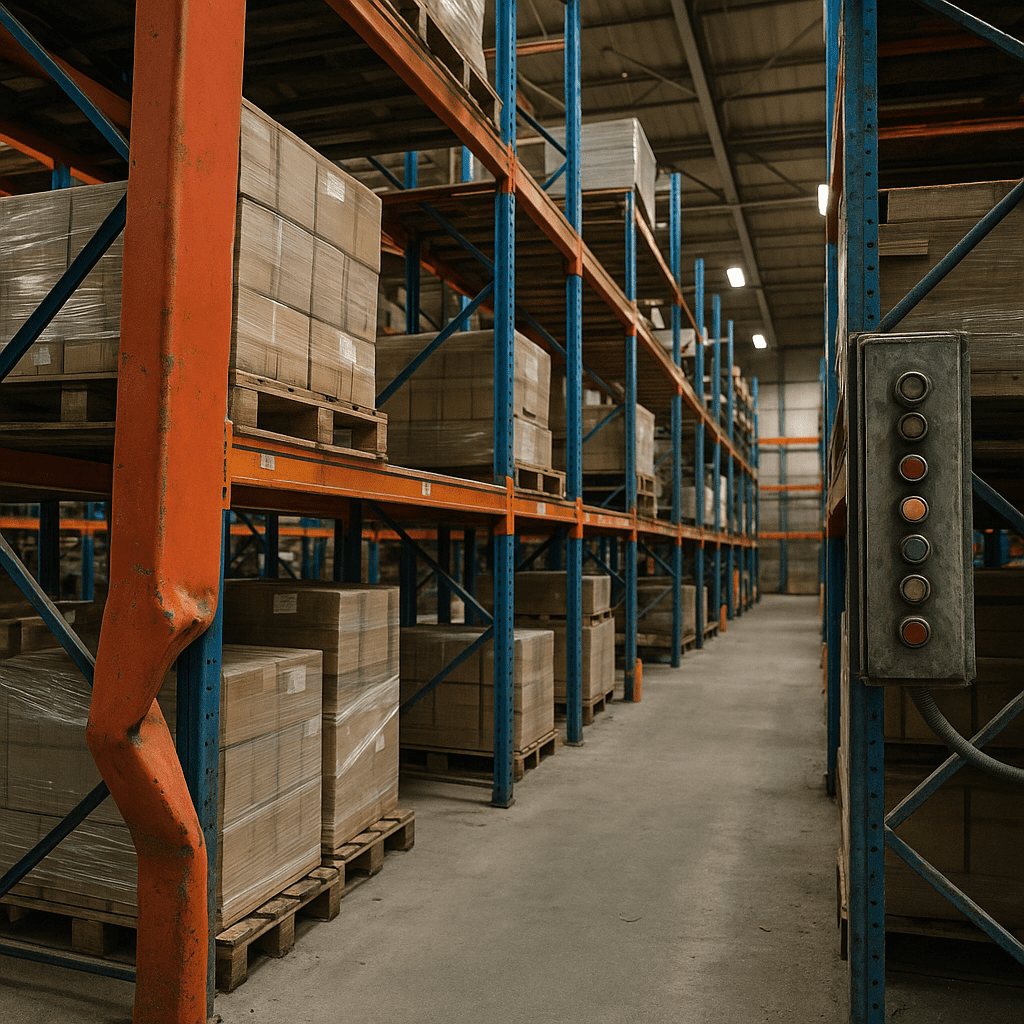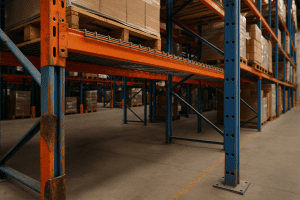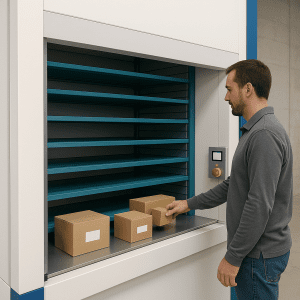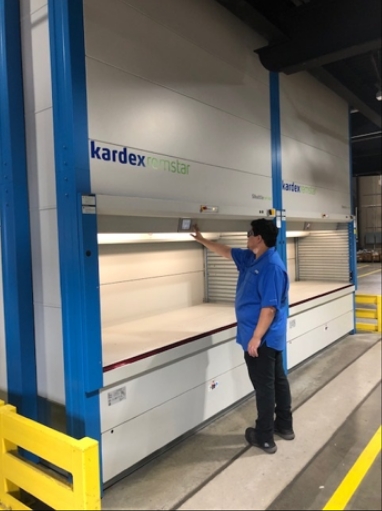There comes a point in every warehouse when the storage that once fueled growth starts slowing it down. The racks still stand, but the layout feels cramped, operators zigzag through aisles, and the maintenance crew is spending more time on repairs than routine checks.
It’s not that the system failed overnight—it’s that it slowly stopped fitting how you work. If you’re seeing bent uprights, outdated controls, or wasted vertical space, it may be time to consider warehouse racking replacement—or a smarter alternative like carousels or VLMs that stretch your square footage vertically.
This article walks through how to recognize the warning signs, decide between upgrading and replacing, and use automation to turn an aging warehouse into a high-performance facility.
Recognizing the signs of aging racking systems
Most racking doesn’t fail all at once. It ages in small, costly ways. You’ll know it’s happening when your team stops trusting certain aisles or when “temporary fixes” start becoming part of the daily workflow.
Here are the key signals to watch for:
1. Physical wear and structural fatigue
Bent or corroded uprights: Even slight bowing or rust can drastically reduce load capacity.
Cracked welds and twisted frames: A sign of repeated overloading or impact damage.
Recurring beam deflection: Indicates beams are under-rated or steel fatigue has set in.
If your racking has been in service for over 10 years without a professional inspection, it’s due. Forklift collisions and minor corrosion compound over time—and can turn into major safety risks.
2. Operational inefficiencies
Long pick paths: More walking equals fewer lines per hour.
Congested hot zones: Frequent traffic jams mean your layout has outgrown your order volume.
Underutilized vertical space: If your warehouse has headroom but your racks stop halfway up, you’re leaving money on the table.
3. Safety and compliance issues
Missing safety pins, unanchored base plates, or mixed manufacturer components all signal non-compliance. OSHA requires racks to be properly labeled with load capacities and inspected regularly. Failing to do so can lead not only to downtime but potential liability.
When these symptoms appear together, it’s time to ask: is repair still responsible—or is it delaying the inevitable?
Replace or upgrade: finding the right balance
Not every worn rack needs full replacement. Some facilities extend lifespan through targeted upgrades, re-slotting, or adding automation. The choice depends on structure, load, and long-term goals.
Full replacement makes sense when:
Structural steel integrity is compromised (bends, corrosion, weld failures).
You’ve shifted from palletized storage to case or tote picking.
Your throughput needs have outgrown the system’s safe capacity.
Upgrading is smarter when:
The rack is sound, but space and speed are limiting growth.
Labor costs are rising faster than throughput.
You can modernize with vertical automation instead of building out.
Hybrid solutions often deliver the best ROI. Many operations replace a portion of static racking while adding vertical carousel storage systems or vertical lift modules (VLMs) for small parts and high-mix SKUs. These systems recapture up to 90% of floor space and shorten walking distance dramatically.
If you simply need to add capacity without changing processes, mobile racking systems compress aisles and unlock up to 50% more storage in the same footprint—no new building required.
How automation redefines return on investment
Traditional racking relies on human movement: walking, bending, and lifting. Automation flips that equation, bringing the item to the person instead of the person to the item. That simple shift compounds over thousands of picks.
Carousels
Rotating shelves deliver stored items directly to the operator. Perfect for uniform items and batch picking. Carousels simplify access control, improve ergonomics, and reduce retrieval time by up to 65%.
VLMs (Vertical Lift Modules)
VLMs use dual trays and an extractor to dynamically adjust tray heights, maximizing vertical cube utilization. Ideal for mixed-height inventory or high-value parts that require precision tracking.
Real-world results often show:
60–70% reduction in walking time
Up to 85% more storage density
99% pick accuracy with light-directed interfaces
Shorter training curves and improved operator safety
Interested in cost comparisons? Use the vertical lift module price guide to estimate project budgets and ROI timelines.
Data and control: the silent backbone of an upgrade
Adding automation without accurate data is like installing a turbocharger on a car with bad tires. Your inventory management layer must evolve too. Systems such as inventory storage solutions maintain real-time visibility into every tray, bin, and pick action—integrating seamlessly with ERP or WMS platforms.
This synchronization ensures replenishment happens before stockouts, and inventory accuracy stays near 100%. When coupled with automation, it’s the difference between a flashy machine and a fully optimized operation.
Safety triggers that demand replacement
Even if you’re not ready to automate, some conditions require immediate action:
Upright damage deeper than 1/8″
Corrosion that compromises weld points
Beam deflection beyond manufacturer limits
Unauthorized drilling or modifications
Unknown load ratings or missing labels
When any of these occur, shut down affected bays and schedule replacement immediately. No productivity gain outweighs the cost of a collapse.
If structural steel still tests sound, consider upgrading controls or carousels with modern electronics. For example, older horizontal systems can be retrofitted with HCB Controls for smarter operation and safety supervision.
Building your ROI case
Start simple:
Measure pick travel time per line item.
Record labor costs per shift.
Estimate the value of recovered space (or deferred expansion cost).
Add mis-pick rates, injury risk, and maintenance downtime.
Then compare two paths:
Scenario A: Replace damaged rack and keep manual workflows.
Scenario B: Shift to automated storage for high-turn items.
Plug in pricing from vertical lift module cost or used equipment and systems and model payback. Most facilities see breakeven in 18–36 months.
Frequently Asked Questions: Warehouse Racking Replacement & Modernization
Q1: How often should racking be inspected?
At least once a year by a qualified professional, and after any forklift impact. Include weekly in-house visual checks for missing anchors or bent steel.
Q2: Is it safe to mix rack components from different brands?
No. Mixing manufacturers can void certifications and reduce capacity. Always replace damaged parts with OEM-approved components.
Q3: Can automation integrate with existing racking?
Yes. Systems like vertical lift modules and vertical carousel storage often complement traditional racking, handling small parts while bulky pallets stay in static locations.
Q4: Are used automated systems reliable?
Reconditioned units from trusted sources are a cost-effective way to modernize. Explore certified Kardex VLMs and second-hand carousels for sale that come with updated controls and warranties.
Q5: How does automation perform in cold or controlled environments?
Modern systems are designed for refrigerated and freezer applications. Review cold storage solutions for examples of vertical automation in subzero spaces.
Q6: What’s the typical lifespan of racking or VLMs?
Quality steel racking can last 15–20 years with maintenance. Automated systems like VLMs or carousels often operate for decades when serviced correctly and upgraded with modern controls.
Q7: What’s the first step if I’m unsure?
Schedule a space analysis. The team can model your layout, evaluate rack condition, and estimate gains from automation before you spend a dollar on hardware.
Final thoughts
Warehouse racking isn’t just about steel and shelves—it’s the backbone of your operation. Knowing when to replace versus when to optimize can mean the difference between another year of patching problems or a decade of productivity.
A thoughtful warehouse racking replacement restores safety and structure; a smart upgrade future-proofs your workflow.
Start by identifying your most constrained zones, benchmark their performance, and explore how a blend of racking, carousels, and VLMs can help. With the right approach, you can transform an aging layout into a modern, efficient, and scalable operation—without expanding a single wall.
When you’re ready, request a complimentary space analysis and discover how much more your warehouse can hold.





